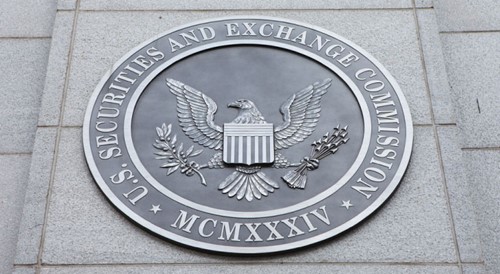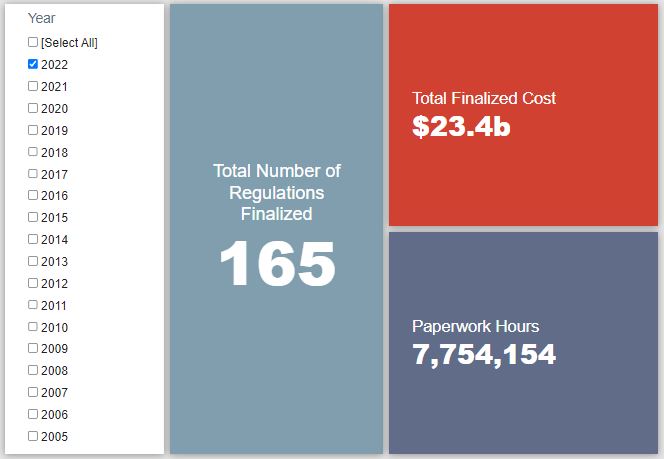Week in Regulation
September 12, 2022
It’s Public Benefits Week in the Federal Register
With a whopping 17 rulemakings that contained some measurable economic impact, last week was a fairly active one in the pages of the Federal Register. It was an unbalanced week as well, however, with many actions providing only middling-at-best effects. A proposed rule from the Department of Health and Human Services (HHS) seeking to make serious revisions to the enrollment process for a handful of benefits programs – including Medicaid, most prominently – dominated the landscape. Across all rulemakings, agencies published $39 billion in total net costs but cut 5.4 million annual paperwork burden hours.
REGULATORY TOPLINES
- Proposed Rules: 33
- Final Rules: 75
- 2022 Total Pages: 55,592
- 2022 Final Rule Costs: $23.4 billion
- 2022 Proposed Rule Costs: $127.6 billion
NOTABLE REGULATORY ACTIONS
The most consequential rulemaking of the week was the HHS rule regarding “Streamlining the Medicaid, Children’s Health Insurance Program, and Basic Health Program Application, Eligibility Determination, Enrollment, and Renewal Processes.” As the title suggests, HHS is seeking to make a series of changes to how, when, and why individuals become enrolled in the listed benefits programs. Broadly, the changes focus on streamlining the application process, increasing the opportunity for automatic enrollment or re-enrollment, and updating certain criteria that, under current policy, provide reason for individuals to become disenrolled. HHS estimates that the proposal would “increase Medicaid enrollment by 2.81 million by 2027.” This would, in turn, create an unfunded mandate requiring states to spend an additional $39.5 billion over five years. The changes made to the application and verification process, however, would reduce the administrative burden on state officials and individuals by 6.9 million hours annually.
The most significant final rule of the week was the Department of Homeland Security (DHS) rule regarding “Public Charge Ground of Inadmissibility.” If that title rings a bell at all, it is because it is the Biden Administration’s replacement for a Trump-era rule on the matter. The original 2019 rule, struck down by a district court ruling, sought to impose a series of administrative requirements for immigrants to certify that they would not be overly dependent on public benefits programs for admissibility purposes. This more recent rule essentially reimposes the policy in place before the 2019 rule. DHS estimates that the administrative burdens involved with this policy amount to total costs of $45 million and nearly 1.4 million annual hours of paperwork. By way of contrast, the Trump-era rule brought $352 million in total costs.
TRACKING THE ADMINISTRATIONS
As we have already seen from executive orders and memos, the Biden Administration will surely provide plenty of contrasts with the Trump Administration on the regulatory front. And while there is a general expectation that the current administration will seek to broadly restore Obama-esque regulatory actions, there will also be areas where it charts its own course. Since the AAF RegRodeo data extend back to 2005, it is possible to provide weekly updates on how the top-level trends of President Biden’s regulatory record track with those of his two most recent predecessors. The following table provides the cumulative totals of final rules containing some quantified economic impact from each administration through this point in their respective terms.
![]()
The Biden Administration’s final rule cost and paperwork totals increased by $156 million and 1.5 million hours, respectively. The public charge rule discussed above was a key part of that trend. As for the other administrations, there was minimal change in the Trump-era totals while the Obama Administration saw a notable uptick in costs. Primarily driven by an Environmental Protection Agency rule on emissions standards for “Portland Cement” plants, Obama-era costs increased by nearly $1 billion.
THIS WEEK’S REGULATORY PICTURE
This week, the Securities and Exchange Commission (SEC) sets new executive pay disclosures.

On September 8, the SEC published a final rule regarding “Pay Versus Performance” in the Federal Register. The rule will require publicly traded companies subject to SEC oversight – registrants, in SEC parlance – to include comparisons of executive pay to the financial performance of the company in information given to shareholders ahead of annual meetings.
The rule stems from a requirement in the Dodd-Frank Wall Street Reform and Consumer Protection Act. Statutory language directed the SEC to develop a rule for the disclosure of “information that shows the relationship between executive compensation actually paid and the financial performance of the issuer.”
The final rule will require registrants to include in any proxy or consent information for an annual shareholder meeting a table showing the relationship between compensation paid to named executive officers (including the isolated compensation of the principle executive officer) and the cumulative total shareholder return (TSR), and the relationship between a registrant’s TSR and the TSR of a peer group chosen by the registrant, over the last five fiscal years.
The rule was first proposed in 2015. In February of this year, the SEC reopened the comment period on the proposed rule to obtain additional feedback and indicate that it finally intended to move forward with a final rule. The final rule contains some modifications, but largely mirrors the proposed rule.
The SEC estimates that the rule will apply to more than 5,400 registrants and add about $12.8 million annually to existing disclosure requirements. That raises the total annual paperwork cost for required information statements provided to shareholders ahead of annual meetings to about $124 million.
TOTAL BURDENS
Since January 1, the federal government has published $151 billion in total net costs (with $23.4 billion in new costs from finalized rules) and 81.5 million hours of net annual paperwork burden increases (with 7.8 million hours in increases from final rules).












